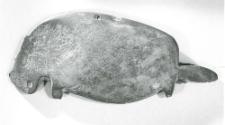Hippopotamus-Shaped Cosmetic Palette
Hippopotamus-Shaped Cosmetic Palette
Artist
Unidentified
Period
Predynastic Period
(Ancient Egyptian, about 4,500–3,100 BCE)
Place of OriginEgypt
DatePredynastic Period, Naqada I–II, about 3800–3300 BCE
Dimensions2 3/4 × 6 3/8 × 1/8 in. (7 × 16.2 × 0.3 cm)
Mediumgreywacke
ClassificationUtilitarian Objects
Credit LineGift of Edward Drummond Libbey
Object number
1906.176
On View
Toledo Museum of Art (2445 Monroe Street), Gallery, 02, Classic
DescriptionA flat, silhouette-style cosmetic palette carved in the form of a standing hippopotamus. The object is shaped from dark stone, presenting a smooth, matte surface with mottled taupe-gray patches. The profile features a thick, oblong body with four short, dependent projections representing legs, a small tapered tail, and a protruding snout. A single perforation is drilled through the dorsal ridge, likely for suspension. The surface exhibits use-wear, including isolated scratches on the belly and whitish pitting or accretions near the tail and back.
Label TextThis greywacke cosmetic palette, carved in the form of a hippopotamus, is an early example of Egyptian personal grooming tools. Palettes like this were used to grind and mix malachite or other minerals into cosmetics, typically for eye paint. While practical in function, these palettes also carried significant symbolic value. The hippopotamus, though a dangerous animal, symbolized fertility, protection, and rebirth, associated with both Taweret, a goddess of childbirth, and Seth, the chaotic god of the desert.Published ReferencesLuckner, Kurt T., "The art of Egypt, Part I," Toledo Museum of Art Museum News, vol. 14, no. 1, Spring 1971, p. 5, repr. fig. 3.
Peck, William H., Sandra E. Knudsen and Paula Reich. Egypt in Toledo: The Ancient Egyptian Collection at the Toledo Museum of Art. Toledo, Toledo Museum of Art, 2011, p. 28, repr. (col.) p. 10, 28.
Exhibition HistoryCincinnati Art Museum; Brooklyn Museum, Mistress of the house, mistress of heaven: Women in ancient Egypt, 1996-1997, no. 23e, p. 80, repr.Toledo Museum of Art, The Egypt Experience: Secrets of the Tomb, October 29, 2010-January 8, 2012.
Predynastic Period, Naqada II, about 3600-3200 BCE
2nd century BCE to 1st century CE, possibly later
2nd century BCE to 1st century CE, possibly later
about 2400 - 2000 BCE
26th Dynasty (664–525 BCE), about 600 BCE
18th Dynasty (1550-1292 BCE), about 1350–1300 BCE
about 510 BCE
Late 17th century - early 18th century
Late 17th century - early 18th century
161-169 CE

Membership
Become a TMA member today
Support TMA
Help support the TMA mission














